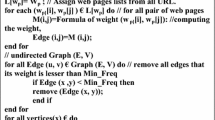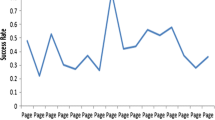Abstract
In the era of ubiquitous computing, applications are emerging to benefit from using devices of different users and different capabilities together. This paper focuses on user-centric web browsing using multiple devices, where content of a web page is partitioned, adapted and allocated to devices in the vicinity. We contribute two novel web page partitioning algorithms. They differ from existing approaches by allowing for both, automatic and semi-automatic partitioning. On the one hand, this provides good automatic, web page independent results by utilizing sophisticated structural pre- and postprocessing of the web page. On the other hand, these results can be improved by considering additional semantic information provided through user-generated web page annotations. We further present a performance evaluation of our algorithms. Moreover, we contribute the results of a user study. These clearly show that (1) our algorithms provide good automatic results and (2) the application of user-centric, annotation-based semantic information leads to a significantly higher user satisfaction.












Similar content being viewed by others
Notes
Proof omitted in this version due to space limitations.
Proof omitted in this version due to space limitations.
References
Ailon N, Charikar M, Newman A (2005) Aggregating inconsistent information: ranking and clustering. In: STOC ’05: proceedings of the thirty-seventh annual ACM symposium on theory of computing. ACM, New York, NY, USA, pp 684–693. doi:10.1145/1060590.1060692
Alapetite A (2010) Dynamic 2d-barcodes for multi-device web session migration including mobile phones. PUC 14:45–52. doi:10.1007/s00779-009-0228-5
Amershi S, Morris MR (2008) Cosearch: a system for co-located collaborative web search. In: Proceeding of the twenty-sixth annual SIGCHI conference on human factors in computing systems, CHI ’08. ACM, New York, NY, USA, pp 1647–1656. doi:10.1145/1357054.1357311
Atterer R, Schmidt A, Wnuk M (2007) A proxy-based infrastructure for web application sharing and remote collaboration on web pages. In: Proc. of the 11th International Conference on Human Computer Interaction (INTERACT)
Bouchet J, Nigay L, Ganille T (2004) ICARE software components for rapidly developing multimodal interfaces. In: Proc. of the International Conference on Multimodal Interfaces (ICMI 2004)
Boykov Y, Veksler O, Zabih R (2001) Fast approximate energy minimization via graph cuts. IEEE Trans Pattern Anal Mach Intell 23(11):1222–1239. doi:10.1109/34.969114
Cai D, Yu S, Wen J, Ma W (2003) Extracting content structure for web pages based on visual representation. In: Proc.5 th Asia pacific web conference, pp 406–417
Chakrabarti D, Kumar R, Punera K (2008) A graph-theoretic approach to webpage segmentation. In: WWW ’08: proceeding of the 17th international conference on World Wide Web. ACM, New York, NY, USA, pp 377–386. doi:10.1145/1367497.1367549
Coles A, Deliot E, Melamed T, Lansard K (2003) A framework for coordinated multi-modal browsing with multiple clients. In: Proc. of the 12th international conference on World Wide Web (WWW ’03). ACM Press, New York, NY, USA, pp 718–726
Dahlhaus E, Johnson DS, Papadimitriou CH, Seymour PD, Yannakakis M (1992) The complexity of multiway cuts (extended abstract). In: STOC ’92: proceedings of the twenty-fourth annual ACM symposium on theory of computing. ACM, New York, NY, USA, pp 241–251. doi:10.1145/129712.129736
Ding Y, Huber J (2008) Designing multi-user multi-device systems—an architecture for multi-browsing applications. In: Proc. of the 7th international ACM conference on mobile and ubiquitous multimedia, pp 8–14
Direct Web Remoting (2011) http://www.directwebremoting.org. Accessed 2 Jan 2012
Fiduccia CM, Mattheyses RM (1988) A linear-time heuristic for improving network partitions. In: 25 years of DAC: papers on twenty-five years of electronic design automation. ACM, New York, NY, USA, pp 241–247. doi:10.1145/62882.62910
Florins M, Vanderdonckt J (2004) Graceful degradation of user interfaces as a design method for multiplatform systems. In: Proc. 9th International Conference on Intelligent User Interfaces (IUI 2004)
Greenberg S, Boyle M, Laberge J (1999) PDAs and shared public displays: making personal information public, and public information personal. PUC 3(1/2):54–64
Han R, Perret V, Naghshineh M (2000) WebSplitter: a unified XML framework for multi-device collaborative web browsing. In: CSCW ’00: proceedings of the 2000 ACM conference on computer supported cooperative work. ACM Press, New York, NY, USA, pp 221–230
Hattori G, Hoashi K, Matsumoto K, Sugaya F (2007) Robust web page segmentation for mobile terminal using content-distances and page layout information. In: WWW ’07: proceedings of the 16th international conference on World Wide Web. ACM, New York, NY, USA, pp 361–370. doi:10.1145/1242572.1242622
Johanson B, Fox A, Winograd T (2002) The interactive workspaces project: experiences with ubiquitous computing rooms. IEEE Pervasive Computing 1(2):67–74
Johanson B, Ponnekanti S, Sengupta C, Fox A (2001) Multibrowsing: moving web content across multiple displays. In: UbiComp ’01: proceedings of the 3rd international conference on Ubiquitous Computing. Springer, London, UK, pp 346–353
Kane S, Karlson A, Meyers B, Johns P, Jacobs A, Smith G (2009) Exploring cross-device web use on pcs and mobile devices. In: INTERACT 2009. Springer, pp 722–735
Kleinberg J, Tardos É (2002) Approximation algorithms for classification problems with pairwise relationships: metric labeling and markov random fields. J ACM 49(5):616–639. doi:10.1145/585265.585268. http://portal.acm.org/ft_gateway.cfm?id=585268&type=pdf&coll=GUIDE&dl=GUIDE&CFID=2588277&CFTOKEN=23748779
Maekawa T, Hara T, Nishio S (2006) A Collaborative web browsing system for multiple mobile users. In: PERCOM ’06: proceedings of the fourth annual IEEE international conference on Pervasive Computing and Communications (PERCOM’06). IEEE Computer Society, Washington, DC, USA, pp 22–35
Maekawa T, Uemukai T, Hara T, Nishio S (2005) Content description and partitioning methods for collaborative browsing by multiple mobile users. In: Proc. of the 16th international workshop on Database and Expert Systems Applications (DEXA’05)
Magerkurth C, Tandler P (2002) Interactive walls and handheld devices—applications for a smart environment. In: Proc. of the workshop collaboration with interactive walls and tables, held in conjunction with UbiComp’02
Myers B (2001) Using handhelds and PCs together. Commun ACM 44(11):34–41
Raghunath M, Narayanaswami C, Pinhanez C (2003) Fostering a symbiotic handheld environment. Comput 36(9):56–65
Tuddenham P, Davies I, Robinson P (2009) Websurface: an interface for co-located collaborative information gathering. In: Proceedings of the ACM international conference on Interactive Tabletops and Surfaces, ITS ’09. ACM, New York, NY, USA, pp 181–188. doi:10.1145/1731903.1731938
Wiltse H, Nichols J (2009) Playbyplay: collaborative web browsing for desktop and mobile devices. In: Proceedings of the 27th international conference on human factors in computing systems, CHI ’09. ACM, New York, NY, USA, pp 1781–1790. doi:10.1145/1518701.1518975
Yahoo User Interface Library (2011) http://developer.yahoo.com/yui/. Accessed 2 Jan 2012
Author information
Authors and Affiliations
Corresponding author
Rights and permissions
About this article
Cite this article
Huber, J., Ding, Y. Adapting web pages using graph partitioning algorithms for user-centric multi-device web browsing. Multimed Tools Appl 62, 209–231 (2013). https://doi.org/10.1007/s11042-011-0980-1
Published:
Issue Date:
DOI: https://doi.org/10.1007/s11042-011-0980-1




